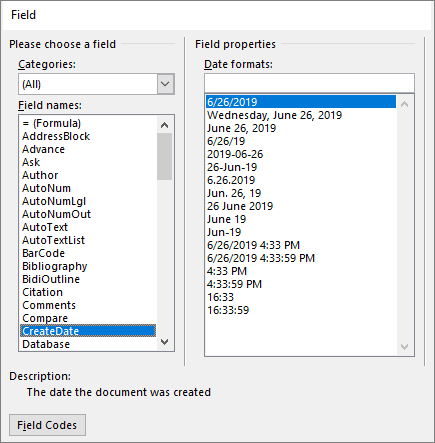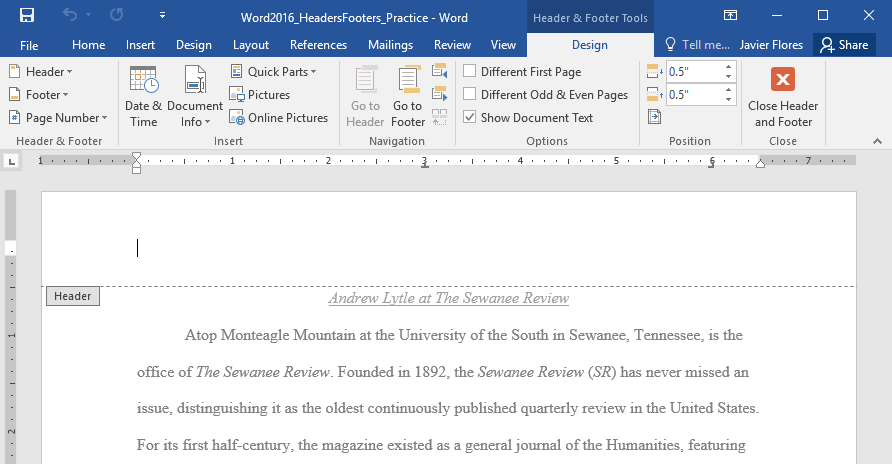
Open the Review tab to use Spell Check, set proofing languages, and to track and review changes to your document. Open the Mailings tab to manage Mail Merge tasks and to work with envelopes and labels. Open the References tab to add a table of contents, footnotes, or a table of citations. Open the Layout tab to work with page margins, page orientation, indentation, and spacing. Open the Design tab to use themes, colors, and effects, such as page borders. Open the Insert tab to insert tables, pictures and shapes, headers, or text boxes. Open the Home tab to use common formatting commands, paragraph styles, and the Find tool. Open the File page to use Backstage view. Move to the Tell Me or Search field on the Ribbon to search for assistance or Help content. Additional tabs might appear depending on your selection in the document. To go directly to a tab on the ribbon, press one of the following access keys. If you don't know the sequence, press Esc and use Key Tips instead. If you know the entire key sequence, go ahead and use it. A notification pops up saying you're using an access key from an earlier version of Microsoft Office. For example, press Alt, and then press one of the old menu keys E (Edit), V (View), I (Insert), and so on.
#Word 2016 header and footer flags full
However, you need to know the full shortcut. In Office 2013 and Office 2010, most of the old Alt key menu shortcuts still work, too. Both offer a largely similar experience, but some options and search results can vary.

Press Alt again to see Key Tips for the options for the selected tab.ĭepending on the version of Office you are using, the Search text field at the top of the app window might be called Tell Me instead. For example, press Alt+H to open the Home tab, and Alt+Q to move to the Tell Me or Search field. You can combine the Key Tips letters with the Alt key to make shortcuts called Access Keys for the ribbon options. Note: Add-ins and other programs can add new tabs to the ribbon and might provide access keys for those tabs. Press the Alt key to display the ribbon shortcuts, called Key Tips, as letters in small images next to the tabs and options as shown in the image below. For example, on the Home tab, the Font group includes the Font Color option. The ribbon groups related options on tabs. Use the arrow keys to select Close, and then press Enter.

Press F6 until the task pane is selected. This table shows the most frequently used shortcuts in Microsoft Word.Ĭut the selected content to the Clipboard.Ĭopy the selected content to the Clipboard.Īlt+W, Q, then use the Tab key in the Zoom dialog box to go to the value you want. Work with references, citations, and indexing
#Word 2016 header and footer flags windows
Get these keyboard shortcuts in a Word document at this link: Word 2016 for Windows keyboard shortcuts. For more information about the features available in Word Starter, see Word Starter feature support. If you are using Microsoft Word Starter, be aware that not all the features listed for Word are supported in Word Starter.

If an action that you use often does not have a shortcut key, you can record a macro to create one. Press Ctrl+F, and then type your search words. When you’re finished, close the Document Inspector dialog and save your changes.To quickly find a shortcut in this article, you can use Search. Simply click on Remove All to delete all headers, footers and watermarks in your document. When the Document Inspector dialog box appears, uncheck all boxes except Headers, Footers, and Watermarks. From the Info pane, click on Check for Issues and then select Inspect Document from the pop-up menu. Open your Word document and go to the File tab of the Ribbon.

Method 2: Remove Header or Footer in Word Using Document Inspector You can use the similar methods to remove the headers from your Word document. Now, all text or other stuff in the footers section should disappear. Just click on Footer and then choose Remove Footer from the drop-down menu. Under the Header & Footer tab of the Ribbon, you will see the Header item and Footer item in the sub-item list. Next, click on the Edit Footer button that appeared. Method 1: Remove Header or Footer in Word via Right-clickĪfter opening your Word document, right-click on the footer at the bottom of any page. How can I remove footers from a Word document prior to printing? This header takes up too much space and you need to delete it? In this tutorial we’ll show you easy ways to remove header and footer in Microsoft Office Word 2019 / 2016.


 0 kommentar(er)
0 kommentar(er)
